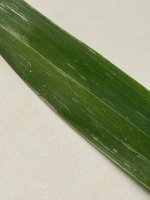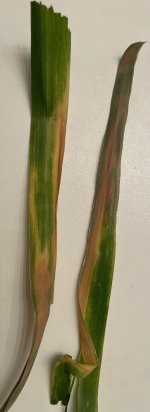braindrops
surrounded by plants
While collecting leaves from a few Phalaris Aquatica and Phalaris Arundinacea plants that are kept indoors, I noticed that some of the leaves had small black dots on them, and some had colorful (tan, brown, and yellow) streaks on them with the same black dots as the others. Attached to this post are some pictures of a few leaves and what I was seeing.
There wasn't much to be found online when looking for Phalaris diseases, however, a search for wheat diseases provided a lot more information to go through (Wheat is also in the pooideae subfamily). One result was Wheat Disease Identification by the University of Tennessee Institute of Agriculture, where the photos and description for Septoria Tritici Blotch (STB) looked very similar to what I was seeing. And according to this (Leaf Blotch Diseases of Wheat—Septoria tritici Blotch, Stagonospora nodorum Blotch and Tan Spot) fact sheet from Ohio State University,
The American Phytopathological Society (APS) has a great page with lots of information on Septoria Tritici:
Septoria tritici blotch (STB) of wheat
From the above APS link:
There is also an interesting section about the potential for biological control:
I haven't come across any information about the use of sulfur or neem oil, but since I have them already I'm going to try them out before purchasing any other fungicides. I've already cut down most of my plants, dusted them with sulfur, and watered them with neem oil.
An update: This was inaffective at treating the issue. The spots and discoloration persist, and one of the plants has lost all leaves.
If anyone has encountered this issue and corrected it, please reply with what corrective action was taken. And if I am way off with what I think is wrong, please post that as well!
There wasn't much to be found online when looking for Phalaris diseases, however, a search for wheat diseases provided a lot more information to go through (Wheat is also in the pooideae subfamily). One result was Wheat Disease Identification by the University of Tennessee Institute of Agriculture, where the photos and description for Septoria Tritici Blotch (STB) looked very similar to what I was seeing. And according to this (Leaf Blotch Diseases of Wheat—Septoria tritici Blotch, Stagonospora nodorum Blotch and Tan Spot) fact sheet from Ohio State University,
which is where my current indoor temperature has been for the past several months....S. tritici is most aggressive under cool conditions with temperatures between 50° and 68°F (15° to 20°C)...
The American Phytopathological Society (APS) has a great page with lots of information on Septoria Tritici:
Septoria tritici blotch (STB) of wheat
From the above APS link:
Several fungicides are used currently to control STB
A major problem for chemical control is that many populations of M. graminicola have rapidly evolved resistance to fungicides, especially to the strobilurin class of chemicals
However, the commonest fungicides currently being applied are azoles
There is also an interesting section about the potential for biological control:
Several biological controls are currently being evaluated for STB, and some have shown promise but none is available yet for commercial production. Fungi belonging to Trichoderma spp. have been used previously as biocontrol agents to protect wheat plants against leaf spot diseases in Argentina. A collection of Bacillus megaterium originating from the wheat rhizosphere and leaves, barley, oat chaff, and grain have been screened for their ability to inhibit STB. This bacterium consistently retarded STB development by up to 80% in small-scale field trials. Pseudomonads also have been tested as potential biocontrol agents. Applications of cells of two isolates of fluorescent pseudomonads from soil to wheat seedlings prior to inoculation with M. graminicola markedly reduced symptom expression. In addition, growth of the antagonistic pseudomonads was not affected by a number of commercial fungicides.
I haven't come across any information about the use of sulfur or neem oil, but since I have them already I'm going to try them out before purchasing any other fungicides. I've already cut down most of my plants, dusted them with sulfur, and watered them with neem oil.
An update: This was inaffective at treating the issue. The spots and discoloration persist, and one of the plants has lost all leaves.
If anyone has encountered this issue and corrected it, please reply with what corrective action was taken. And if I am way off with what I think is wrong, please post that as well!



